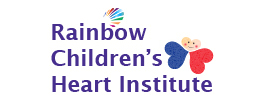Ventricular septal defect, or VSD, is a heart defect that babies are born with, i.e., it is congenital. It is a defect in the form of a hole in the wall separating the left and right ventricles of the heart. It is the most common form of congenital heart disease treated at Rainbow Children’s Heart Institute, a top heart hospital in Hyderabad.
There are four chambers in the heart: 2 atrium and 2 ventricles. Blood with high oxygen content flows to the left ventricle from the left atrium and finally out to the body for vital organs to use the oxygen. Blood that has less oxygen content flows to the right ventricle from the right atrium and finally out to the lungs, where it picks up oxygen.
In normal circumstances, the septal wall avoids the blood from being mixed between the heart ventricles. However, with a VSD, oxygen-rich blood abnormally passes through the septal opening from the left ventricle, where it mixes with oxygen-deficient blood in the right ventricle.
If the VSD is large, it can cause high blood pressure in the lungs, which can cause the oxygen levels to be lowered. If your kid has a large VSD, there may be a need for some sort of repair. Children having larger VSDs show symptoms like hard and fast breathing. If the hole in the septum is very small, it might not allow the passing of much blood between the ventricles. In such cases, the lungs and heart do not have to work harder. Such small holes may even close up themselves.
There are different kinds of VSD, depending on the specific part of the wall that is involved. As mentioned before, the size of the hole also tends to vary. In most cases, the cause of VSD is unknown. However, VSD tends to occur more frequently in some families due to certain genetic issues.
Symptoms of VSD
Symptoms of VSD may show from birth itself or the child may not show any symptoms before they grow a little older. The severity of the symptoms is dependent on the size of the hole as well as the age of your child when the symptoms initially appear. In the case of small holes, there may be a heart murmur that can be heard with a stethoscope. On the other hand, the lungs and heart need to work harder in the case of larger openings. It can cause symptoms like:
- Tiredness
- Trouble breathing
- Fast breathing
- Rapid heart rate
- Pale skin
- Enlarged liver
- Poor weight gain
- Tiring while feeding or poor feeding in general
Symptoms can be different in each case. Furthermore, VSD symptoms are also similar to that of other health conditions. Always consult the best heart surgeon in Hyderabad at Rainbow Children’s Heart Institute to get a proper diagnosis.
Diagnosis of VSD in children
When your pediatrician is listening to your kid’s heart using a stethoscope, they might hear an abnormal sound, which could be an indication of some problem. In that case, you may be referred to a pediatric heart doctor. The pediatric cardiologist will check your child by listening to his/her lungs and heart. The doctor may need to perform additional tests for confirming the diagnosis. The diagnosis tests need to be performed depending on the age and condition of the child, as well as the preference of the doctor. Following diagnostic tests are commonly used:
- Chest X-ray
- Electrocardiogram (ECG)
- Echocardiogram (echo)
Treatment of pediatric VSD
The treatment of pediatric VSD depends on the age, symptoms, and overall health of the child. It also depends on the severity of the condition. If the hole is small, it may itself close as the child grows. Some small holes might not close by themselves as they might not require treatment. If the hole is large, it may have to be fixed through cardiac catheterization or with surgery. After diagnosing your child with VSD, the doctor will monitor the condition regularly to check if it closes up on its own.
- Medicine: Children who do not have symptoms might not need medicine, while some children may have to take medicine for helping the heart work better.
- Nutrition: Babies may get tired while feeding if they have large VSD, as a result, they might not be able to gain enough weight by eating. They may need supplemental tube feedings and high-calorie breastmilk or formula
- Surgery or cardiac catheterization: These are invasive methods to treat VSD.
